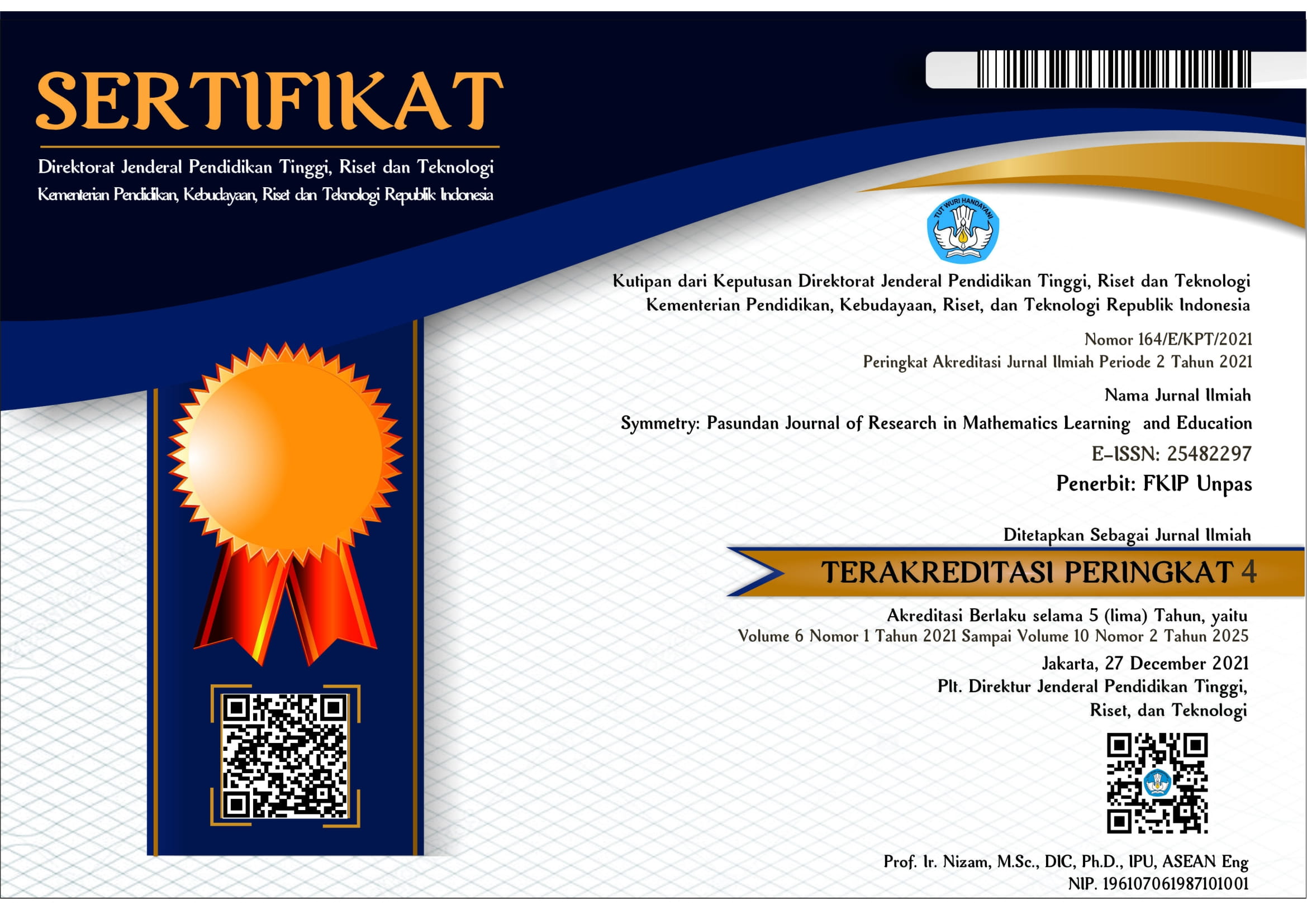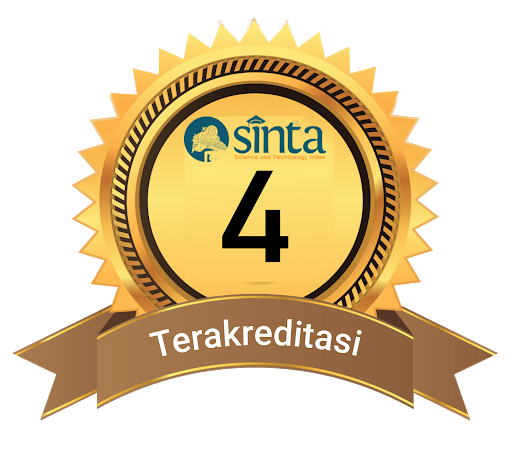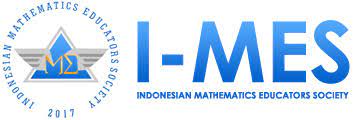ETHNOMATHEMATICS AND BATIK CULTURAL CONVERSATION: A QUALITATIVE-ETHNOGRAPHIC STUDY OF MATHEMATICAL CONCEPTS IN BATIK CEPLOK KASATRIAN
DOI:
https://doi.org/10.23969/symmetry.v10i1.28298Abstract
Batik Ceplok Kasatrian is an Indonesian cultural heritage that is full of philosophical meaning but is less known by the younger generation. Therefore, the integration of batik in mathematics learning can be one of the strategies to preserve tradition of batik culture. This research aims to explore mathematical concepts, such as geometry, algebra, arithmetic, and statistics, in Batik Ceplok Kasatrian motifs. This research uses qualitative-ethnographic. The subject of this study is the Batik Ceplok Kasatrian motif. Data validity is obtained through source triangulation, while data analysis includes reduction, presentation, and conclusion. The exploration process is carried out by answering four main questions: "Where do I begin exploring?", "How can I discover it?", "How will I know if it has discovered something important?", and "How can I make sense of it?". The results show that of the four mathematical concepts, only two mathematical concepts are found in this batik, namely geometry and arithmetic. Geometry subconcepts include transformation (reflection, translation, dilation) and plane geometry (line segments, symmetry, congruence). Arithmetic subconcept includes integers (odd-even numbers). These findings can be integrated into mathematics learning through the development of ethnomathematics-based assessments oriented towards High Order Thinking Skills.
Downloads
References
Aini, D. N., Umpi, R., & Rahman, A. A. (2024). The vital role of civics : Understanding local identity and preserving cultural heritage in promoting local culture : (An ethnographic study in Sumberdem village , Malang regency). International Journal of Multicultural and Multireligious Understanding, 11(2), 283–293. https://doi.org/10.18415/ijmmu.v11i2.5386
Akarsu, M. (2022). Understanding of Geometric Reflection: John’s learning path for geometric reflection. Journal of Theoretical Educational Science, 15(1), 64–89. https://doi.org/10.30831/akukeg.952022
Andriani, S., & Indri, S. (2020). Etnomatematika Motif Ceplokan Batik Yogyakarta dalam Peningkatan Pemahaman Konsep Matematika Siswa. Delta: Jurnal Ilmiah Pendidikan Matematika, 8(1), 81–92. https://doi.org/10.31941/delta.v8i1.966
Antara, I. G. W. S. (2023). Post-Pandemic Learning: Integration of Local Wisdom As a Learning Concept for Elementary School Students. Adi Widya: Jurnal Pendidikan Dasar, 8(1), 11–17. https://doi.org/10.25078/aw.v8i1.2112
Arwanto, A. (2017). Eksplorasi Etnomatematika Batik Trusmi Cirebon untuk Mengungkap Nilai Filosofi dan Konsep Matematis. Phenomenon: Jurnal Pendidikan MIPA, 7(1), 40–49. https://doi.org/10.21580/phen.2017.7.1.1493
Astriandini, M. G., & Kristanto, Y. D. (2021). Kajian Etnomatematika Pola Batik Keraton Surakarta Melalui Analisis Simetri. Mosharafa: Jurnal Pendidikan Matematika, 10(1), 13–24. https://doi.org/10.31980/mosharafa.v10i1.637
Biran, A. (2019). Geometrical Transformations. In Geometry for Naval Architects (pp. 325–360). https://doi.org/10.1016/B978-0-08-100328-2.00019-5
Bourchtein, L., & Bourchtein, A. (2022). Theory of Infinite Sequences and Series. Springer Nature.
Castro, R. S. de. (2024). Weaving the Harmony of Cultures into the Infinite Tapestry of Mathematics. Revista ARACÊ, 6(1), 219–230. https://doi.org/10.56238/arev6n1-013 Submitted
Cendana, S. C. (2016). Pesona Keramik Dalam Busana Art Wear Dengan Aplikasi Motif Batik Ceplok. CORAK Jurnal Seni Kriya, 4(2), 137–145. https://doi.org/10.24821/corak.v4i2.2369
Conway, J. H., Burgiel, H., & Goodman-Strauss, C. (2008). The Symmetries of Things. Taylor & Francis.
Cummins, J., Kennedy, P., & Yunker, L. (2005). Geometry: Concepts and Applications. McGraw-Hill Education.
D’Ambrosio, U. (1985). Ethnomathematics and Its Place in the History and Pedagogy of Mathematics. For the Learning of Mathematics, 5(1), 44–48. https://www.jstor.org/stable/40247876
Dahoklory, A. S. K., Laurens, T., & Palinussa, A. L. (2023). Development of Learning Devices Based on Ethnomathematics of the Meher Tribe Woven Fabrics (Kisar Island) With Realistic Mathematics Education Approach on Number Pattern Material. Jurnal Pendidikan Matematika (JUPITEK), 6(2), 82–92. https://doi.org/10.30598/jupitekvol6iss2pp82-92
Faiziyah, N., Khoirunnisa, M., Azizah, N. N., Nurrois, M., Prayitno, H. J., Desvian, Rustamaji, & Warsito. (2021). Ethnomathematics: Mathematics in Batik Solo. Journal of Physics: Conference Series, 1720(1), 1–6. https://doi.org/10.1088/1742-6596/1720/1/012013
Febriani, R., Knippenberg, L., & Aarts, N. (2023). The making of a national icon: Narratives of batik in Indonesia. Cogent Arts and Humanities, 10(1), 1–16. https://doi.org/10.1080/23311983.2023.2254042
Fitri, N. L., & Prahmana, R. C. I. (2020). Designing learning trajectory of circle using the context of Ferris wheel. JRAMathEdu: Journal of Research and Advances in Mathematics Education, 5(3), 247–261. https://doi.org/10.23917/jramathedu.v5i3.10961
Gadeng, A. N., Desfandi, M., Ridha, S., Ruliani, R., & Shafida, M. (2024). The Knowledge Levels of Generation Z Toward Local Wisdom of Aceh Community for Disaster Mitigation. International Journal of Disaster Management, 7(2), 129–142. https://doi.org/10.24815/ijdm.v7i2.37242 RESEARCH
Hakim, L. M. (2018). Batik Sebagai Warisan Budaya Bangsa dan Nation Brand Indonesia. Nation State: Journal of International Studies, 1(1), 61–90. https://doi.org/10.24076/nsjis.2018v1i1.90
Downloads
Published
Issue
Section
License
Copyright (c) 2025 Symmetry: Pasundan Journal of Research in Mathematics Learning and Education

This work is licensed under a Creative Commons Attribution 4.0 International License.
Hak Cipta sepenuhnya ditangan jurnal.



















